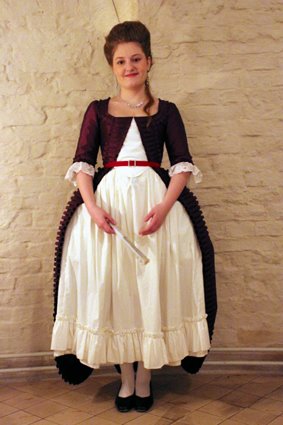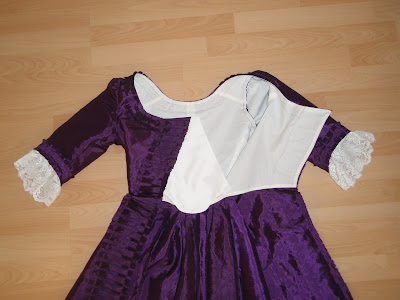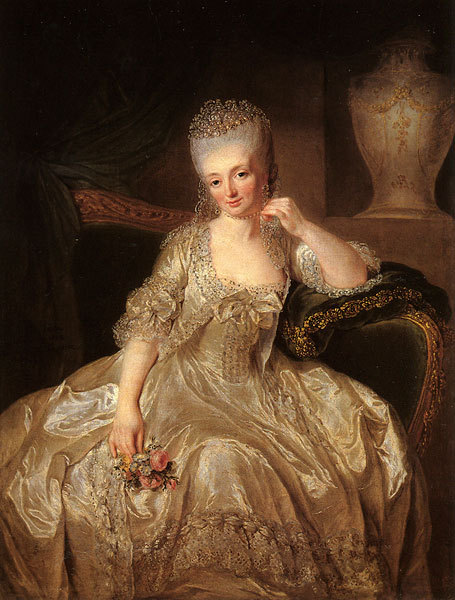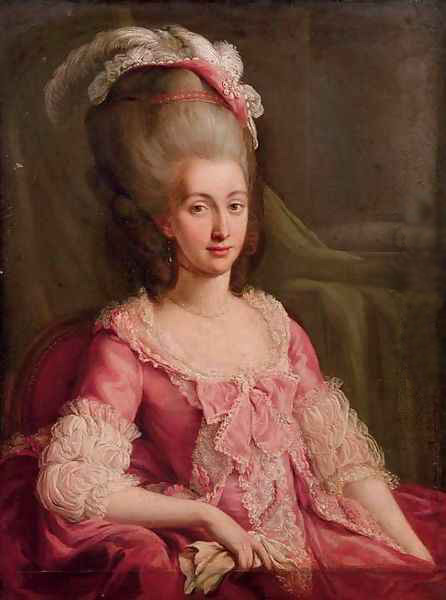Front view of the dress.
I didn't manage to sew a matching petticoat but luckily one of my old petticoats goes quite nicely with it, don't you think? I do have the fabric for the new one so I'm going to make it when I can.
There is about 4 cm wide pleating on the neck and sleeves and 8 cm wide pleating on the edges of front, widening to 10 cm after waistline. Red velvet band with a square buckle on the waist. The front fits close to skin on the waist unlike many of the polonaises that just seem to hang over the waist. I'm just not that fond of loosely fitting garments, though I don't think it looks bad at all now that I'm used to it. I'm very happy with the fit of the dress. It was a real struggle to fit the sleeves well on my own...
I didn't manage to sew a matching petticoat but luckily one of my old petticoats goes quite nicely with it, don't you think? I do have the fabric for the new one so I'm going to make it when I can.
There is about 4 cm wide pleating on the neck and sleeves and 8 cm wide pleating on the edges of front, widening to 10 cm after waistline. Red velvet band with a square buckle on the waist. The front fits close to skin on the waist unlike many of the polonaises that just seem to hang over the waist. I'm just not that fond of loosely fitting garments, though I don't think it looks bad at all now that I'm used to it. I'm very happy with the fit of the dress. It was a real struggle to fit the sleeves well on my own...
And the back... While dancing! The skirt is lifted up with two strings and the velvet band is tied to a bow at the back. The pleating continues all the way around the hem...
And a couple of other photos, with kind of silly faces, but anyway...
The whole dress laid out on the floor.
The same on the inside. And yes, I know you shouldn't sew the lace into the sleeves but I got really frustrated about detachable sleeve ruffles and didn't want to make several shifts just to get different kinds of laces to different dresses.
The front closes with pins on the other side and the white stomacher is sewn into the dress on the other side.
Three seams in the back. First I was considering adding golden cord with tassels on the seams but in the end I thought it looked better without.
For the first time I didn't want any machine-sewing to be seen on the outside so I stiched everything by hand, except the seams on the inside, of course.
As a conclusion, I'm quite satified with this dress and it has to be my favourite in my 18th century garderobe at the moment. I think I will never do everything by hand because it's just not my thing, plus I don't consider myself as a reenactor, but a costume maker/lover. And I also just don't have the time nor the will to make everything by hand. Making this dress took so much of my time from other things that I'm atually left behind in my studies (ouchy!), plus I felt so bad because I wasn't paying much attention to my partner and my friends because I was just sewing the whole spare time that I had! So for a while I think I'm forced to put aside all my 18th century sewing projects - no matter how much I'd love to sew them now, specially because I'm feeling inspired after meeting so many other awesome costumers.
Some decorations that I used for my hair and the velvet band with a lovely square buckle..
The photos of me wearing the dress were captured by two lovely ladies, madame Petranella and Katariina Augustintytär (Read her blog here: Before the Automobile). Thanks to both of them!
Ps. I appologize for any typos that I might have made... I try to write correctly and read though the whole text carefully a couple of times before submitting it but usually I still find a few typos later on. Please, do note me about them if you notice any, so that I can correct them.






























































